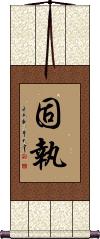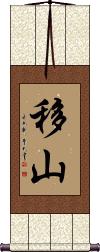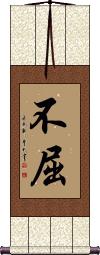Many custom options...
And formats...

Persistence in Chinese / Japanese...
Buy a Persistence calligraphy wall scroll here!
Personalize your custom “Persistence” project by clicking the button next to your favorite “Persistence” title below...
Persistence
固執 can also mean “opinionated” or “stubborn” in Chinese and Japanese, but in the nicest way possible (still bad).
This just means “stubborn” in Korean (not a good scroll if your audience is Korean, in fact, we don't recommend this word at all). There are better ways to express this idea, such as tenacity/tenacious or perseverance... ...see the links below...
See Also: Tenacious | Fortitude | Perseverance
Nothing is Impossible with Persistence
移山 is the Chinese, Japanese Kanji, and old Korean Hanja for “to remove mountains” or “to move a mountain.”
Figuratively, this means you can accomplish the impossible by sheer persistence.
移山 is the short form of a proverb about a man who had much persistence and could move a whole mountain (a bucket of soil at a time).
Indomitable / Persistence / Fortitude
不屈 is the short form of a longer Chinese word and also a word used in Korean and Japanese to express the idea of being indomitable. It literally means “will not bend,” “will not crouch,” “will not yield,” “will not flinch,” or “will not submit.”
Note: Some will translate this as “indomitable spirit”; however, technically, there is no character to suggest the idea of “spirit” in this word.
Undaunted After Repeated Setbacks
Persistence to overcome all challenges
百折不撓 is a Chinese proverb that means “Be undaunted in the face of repeated setbacks.”
More directly translated, it reads, “[Overcome] a hundred setbacks, without flinching.” 百折不撓 is of Chinese origin but is commonly used in Japanese and somewhat in Korean (same characters, different pronunciation).
This proverb comes from a long, and occasionally tragic story of a man that lived sometime around 25-220 AD. His name was Qiao Xuan, and he never stooped to flattery but remained an upright person at all times. He fought to expose the corruption of higher-level government officials at great risk to himself.
Then when he was at a higher level in the Imperial Court, bandits were regularly capturing hostages and demanding ransoms. But when his own son was captured, he was so focused on his duty to the Emperor and the common good that he sent a platoon of soldiers to raid the bandits' hideout, and stop them once and for all even at the risk of his own son's life. While all of the bandits were arrested in the raid, they killed Qiao Xuan's son at first sight of the raiding soldiers.
Near the end of his career, a new Emperor came to power, and Qiao Xuan reported to him that one of his ministers was bullying the people and extorting money from them. The new Emperor refused to listen to Qiao Xuan and even promoted the corrupt Minister. Qiao Xuan was so disgusted that in protest, he resigned from his post as minister (something almost never done) and left for his home village.
His tombstone reads “Bai Zhe Bu Nao” which is now a proverb used in Chinese culture to describe a person of strong will who puts up stubborn resistance against great odds.
My Chinese-English dictionary defines these 4 characters as “keep on fighting despite all setbacks,” “be undaunted by repeated setbacks,” and “be indomitable.”
Our translator says it can mean “never give up” in modern Chinese.
Although the first two characters are translated correctly as “repeated setbacks,” the literal meaning is “100 setbacks” or “a rope that breaks 100 times.” The last two characters can mean “do not yield” or “do not give up.”
Most Chinese, Japanese, and Korean people will not take this absolutely literal meaning but will instead understand it as the title suggests above. If you want a single big word definition, it would be indefatigability, indomitableness, persistence, or unyielding.
See Also: Tenacity | Fortitude | Strength | Perseverance
Indomitable / Unyielding
不屈不撓 means “Indomitable” or “Unyielding.”
不屈不撓 is a long word by Chinese standards. At least, it is often translated as a single word into English. It's actually a proverb in Chinese.
If you want to break it down, you can see that the first and third characters are the same. Both mean “not” (they work as a suffix to make a negative or opposite meaning to whatever character follows).
The second character means “bendable.”
The last means “scratched” or “bothered.”
So this really means “Won't be bent, can't be bothered.” I have also seen it written as “Will not crouch, will not submit.” This comes from the fact that the second character can mean “to crouch” and the last can mean “to submit” (as in “to give in” such as “submitting to the rule of someone else”). This may explain better why these four characters mean “indomitable.”
Notes:
Some will translate this as “indomitable spirit”; however, technically, there is no character to suggest the idea of “spirit” in this word.
Other translations include indefatigability, indomitableness, or unremitting tenacity.
The first two characters can be stand-alone words in Chinese.
In Japanese, this is considered two words (with very similar meanings). It's more common to see the word order flipped to 不撓不屈 in Japanese.
The same characters are used in old Korean Hanja. Just like in Japanese, the words are swapped to 不撓不屈 creating a word pronounced “불요불굴” in Korean.
See 不撓不屈
These search terms might be related to Persistence:
Determination
Determination to Achieve
Determination to Achieve / Will-Power
Devotion / Diligence / Vigorous / Energetic
Diligence
Esprit De Corps / Determination
Kenninfubatsu - Indomitable Perseverance
Never Forget Your First Resolution
Patience / Perseverance
Patience / Perseverance / to Endure / Tolerant
Perseverance
Perseverance / Fortitude
Perseverance / Indomitable / Invincible Fortitude
Perseverance / Will-Power
Perseverance is the Key
Rise Up With Thrift and Diligence
Unswerving Determination / Firm and Persistent
Unwavering Determination and Resolve
Not the results for persistence that you were looking for?
Below are some entries from our dictionary that may match your persistence search...
| Characters If shown, 2nd row is Simp. Chinese |
Pronunciation Romanization |
Simple Dictionary Definition |
不屈 see styles |
bù qū bu4 qu1 pu ch`ü pu chü fukutsu ふくつ |
More info & calligraphy: Indomitable / Persistence / Fortitude(n,adj-no,adj-na) persistence; fortitude; indomitability |
固執 固执 see styles |
gù zhí gu4 zhi2 ku chih koshitsu(p); koshuu / koshitsu(p); koshu こしつ(P); こしゅう |
More info & calligraphy: Persistence(n,vs,vt,vi) sticking to (an opinion, theory, belief, etc.); clinging to; adherence; persistence; insistence |
持久 see styles |
chí jiǔ chi2 jiu3 ch`ih chiu chih chiu jikyuu / jikyu じきゅう |
More info & calligraphy: Endurance(noun/participle) endurance; persistence; (place-name) Jikyū |
耐久力 see styles |
taikyuuryoku / taikyuryoku たいきゅうりょく |
More info & calligraphy: Stamina / Endurance |
執 执 see styles |
zhí zhi2 chih mamoru まもる |
to execute (a plan); to grasp (archaism) attachment; obsession; persistence; (male given name) Mamoru grah, grabh ; graha. To seize, grasp, hold on to, maintain; obstinate. |
恒 see styles |
héng heng2 heng wataru わたる |
variant of 恆|恒[heng2] (given name) Wataru Constant; perseverance, persistence; translit. ga, ha. |
住劫 see styles |
zhù jié zhu4 jie2 chu chieh juukou / juko じゅうこう |
{Buddh} (See 四劫) the kalpa of existence (the second aeon of the universe) vivartasiddhakalpa; the abiding or existing kalpa; the kalpa of human existence; v. 劫. |
固持 see styles |
koji こじ |
(noun, transitive verb) adherence (to one's beliefs); persistence; sticking to one's guns; standing one's ground |
執念 执念 see styles |
zhí niàn zhi2 nian4 chih nien shuunen / shunen しゅうねん |
obsession (CL:股[gu3]); (when followed by 於|于[yu2]) to be obsessive (about) tenacity; persistence; obsession; implacability |
存続 see styles |
sonzoku そんぞく |
(n,vs,vt,vi) continuance; survival; persistence; retention; duration |
根気 see styles |
konki こんき |
patience; perseverance; persistence; tenacity; energy |
粘り see styles |
nebari ねばり |
(1) stickiness; viscosity; (2) tenacity; persistence |
耐久 see styles |
nài jiǔ nai4 jiu3 nai chiu taikyuu / taikyu たいきゅう |
durable; long-lasting endurance; persistence |
腰骨 see styles |
yāo gǔ yao1 gu3 yao ku koshibone こしぼね |
lumbar vertebrae (1) hipbone; innominate bone; (2) fortitude; perseverance; endurance; persistence |
遺残 see styles |
izan いざん |
(noun - becomes adjective with の) persistence; vestigial remnant |
根負け see styles |
konmake こんまけ |
(n,vs,vi) being beaten by one's opponent's persistence; being outlasted; running out of patience; giving in; succumbing (to) |
一点張り see styles |
ittenbari いってんばり |
(1) persistence; single-mindedness; sticking to one point; focusing on one thing; (2) (orig. meaning) always making the same bet |
ペーシェンス see styles |
peeshensu ペーシェンス |
(1) patience (game); solitaire; (2) patience; perseverance; persistence |
ペイシェンス see styles |
peishensu / peshensu ペイシェンス |
(1) patience (game); solitaire; (2) patience; perseverance; persistence |
パーシステンス see styles |
paashisutensu / pashisutensu パーシステンス |
{comp} persistence |
一口吃不成胖子 see styles |
yī kǒu chī bù chéng pàng zi yi1 kou3 chi1 bu4 cheng2 pang4 zi5 i k`ou ch`ih pu ch`eng p`ang tzu i kou chih pu cheng pang tzu |
lit. you cannot get fat with only one mouthful (proverb); fig. any significant achievement requires time, effort and persistence |
持続的な有効性 see styles |
jizokutekinayuukousei / jizokutekinayukose じぞくてきなゆうこうせい |
{comp} persistence |
Variations: |
oshi(p); oshi おし(P); オシ |
(1) push; pushing; (2) weight; pressure; (3) authority; forcefulness; boldness; audacity; persistence; (prefix) (4) (押し only) (before a verb) to forcibly ...; to strongly ...; (5) (kana only) {go} (usu. オシ) push; pushing; extending your stones forward by pushing against opponent's stones |
天下無難事,只怕有心人 天下无难事,只怕有心人 |
tiān xià wú nán shì , zhǐ pà yǒu xīn rén tian1 xia4 wu2 nan2 shi4 , zhi3 pa4 you3 xin1 ren2 t`ien hsia wu nan shih , chih p`a yu hsin jen tien hsia wu nan shih , chih pa yu hsin jen |
lit. there is nothing the determined person can't accomplish (idiom); fig. persistence will overcome |
Variations: |
ittenbari いってんばり |
(1) persistence; single-mindedness; sticking to one point; focusing on one thing; (2) (orig. meaning) always making the same bet |
The following table may be helpful for those studying Chinese or Japanese...
| Title | Characters | Romaji (Romanized Japanese) | Various forms of Romanized Chinese | |
| Persistence | 固執 固执 | koshuu / koshu | gù zhí / gu4 zhi2 / gu zhi / guzhi | ku chih / kuchih |
| Nothing is Impossible with Persistence | 移山 | isan | yí shān / yi2 shan1 / yi shan / yishan | i shan / ishan |
| Indomitable Persistence Fortitude | 不屈 | fukutsu | bù qū / bu4 qu1 / bu qu / buqu | pu ch`ü / puchü / pu chü |
| Undaunted After Repeated Setbacks | 百折不撓 百折不挠 | hyaku setsu su tou hyakusetsusutou hyaku setsu su to | bǎi zhé bù náo bai3 zhe2 bu4 nao2 bai zhe bu nao baizhebunao | pai che pu nao paichepunao |
| Indomitable Unyielding | 不屈不撓 不屈不挠 | fu kutsu fu tou fukutsufutou fu kutsu fu to | bù qū bù náo bu4 qu1 bu4 nao2 bu qu bu nao buqubunao | pu ch`ü pu nao puchüpunao pu chü pu nao |
| In some entries above you will see that characters have different versions above and below a line. In these cases, the characters above the line are Traditional Chinese, while the ones below are Simplified Chinese. | ||||
Successful Chinese Character and Japanese Kanji calligraphy searches within the last few hours...








